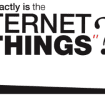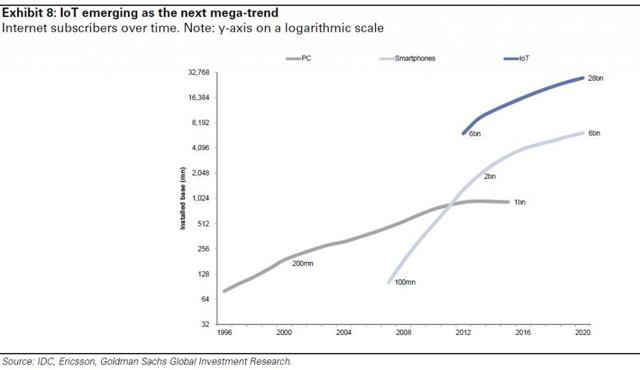The Internet of Things is starting to take over all aspects of life. More and more devices and even appliances are connecting to the Internet, not only supposedly making our lives more convenient, but also making them inherently more complicated in some ways. The Internet of Things has already had a major impact on Consumer segments over the last 15 years and now it is beginning to move into Industrials, where a Goldman Sachs team of analysts thinks the economic impact will be greater. Here’s what they had to say and how it will impact your way of life.
devices and even appliances are connecting to the Internet, not only supposedly making our lives more convenient, but also making them inherently more complicated in some ways. The Internet of Things has already had a major impact on Consumer segments over the last 15 years and now it is beginning to move into Industrials, where a Goldman Sachs team of analysts thinks the economic impact will be greater. Here’s what they had to say and how it will impact your way of life.
The above introductory comments are edited excerpts from an article* by Michelle Jones (ValueWalk.com) entitled How The Internet Of Things Impacts Industrials.
The following article is presented courtesy of Lorimer Wilson, editor of www.munKNEE.com (Your Key to Making Money!), and www.FinancialArticleSummariesToday.com (A site for sore eyes and inquisitive minds) and has been edited, abridged and/or reformatted (some sub-titles and bold/italics emphases) for the sake of clarity and brevity to ensure a fast and easy read. This paragraph must be included in any article re-posting to avoid copyright infringement.
Jones goes on to say in further edited excerpts:
In a report dated July 16, 2014, analyst Joe Ritchie and the rest of his team at Goldman Sachs said the Internet of Things is impacting the Industrial segment by creating a shift from hardware to software.
(click to enlarge)
The economics of the Internet of Things
The Internet of Things has already had a major impact on Consumer segments over the last 15 years or so. Now it is beginning to move into Industrials, where the Goldman Sachs team thinks the economic impact will be greater. They expect the segment to make up $2 trillion of the $7 trillion total addressable market by 2020. IDC estimates that currently, the Internet of Things has an installed base of around 9.1 billion devices. They break it into three main verticals: Building Automation, Manufacturing and Resources.
(click to enlarge)
The analysts compare the impact of connected devices in the Industrial sector as being similar to the Industrial Revolution. Equipment is becoming more connected and digitized as machines connect to networks, thus creating new ecosystems.
Industrial companies rethink business models
They note that there are a number of infrastructure booms ending and that competition across borders is increasing. As a result, they expect industrial companies to move from hardware to software. They say that already, fixed investment growth is moving more and more toward software rather than “traditional capital goods equipment. The result is new business models “that more seamlessly integrate hardware and software offerings.”
(click to enlarge)
They say these models offer more recurring revenue streams and greater penetration of smart devices, as well as inexpensive big data processing and low cost bandwidth or wireless coverage. The analysts believe acquisitions will play a major role as companies move toward building out their capabilities. They say the biggest interest will likely be in buying data management and analysis companies.
Home automation leads the way
Just as Consumer segments had a head start in adopting the Internet of Things, so they expect home automation to lead the way for Industrials. They note that homes make up more than 30% of electricity usage and naturally overlap with consumer devices like smartphones. Also there’s more room for homes to digitize.
(click to enlarge)
The Consumer Electronics Association estimates that about 10% of new U.S. homes currently have home automation. However, the Goldman Sachs team expects this to grow significantly due to the rapid growth in the smartphone user base. They’re estimating that today’s 1.9 billion smartphone users will grow to 4 billion in 2016.
As home automation grows, they say the key areas of focus for Industrials will grow. Those areas include home energy efficiency, comfort and security.
Editor’s Note: The author’s views and conclusions in the above article are unaltered and no personal comments have been included to maintain the integrity of the original post. Furthermore, the views, conclusions and any recommendations offered in this article are not to be construed as an endorsement of such by the editor.
*http://www.valuewalk.com/2014/07/how-the-internet-of-things-impacts-industrials/ (© 2014 ValueWalk LLC All Rights Reserved; Sign up for our free daily newsletter)
Follow the munKNEE!
- Register for our Newsletter (sample here)
- Find us on Facebook
- Follow us on Twitter (#munknee)
- Subscribe via RSS
Related Articles:
1. What Is – Why Invest In – the New “Internet of Things” (IoT) Market?
By next year there will be twice as many devices connected to the Internet as there are people in the world, according to some estimates, and by the end of the decade, that number may hit 50 billion. This burgeoning market is referred to as the Internet of Things (IoT). This infographic provides a description of the developing IoT space and identifies major companies who are shaping this new market sector and worth looking at for exposure to this important trend. Read More »
2. The Next Step In Technology Is the “Internet of Things” & These Companies Have Exposure To It
Technology companies have a history of not getting along, but if they’re going to be successful in the so-called “Internet of Things” (IoT), they’ll have to find a way to do it. This article focuses on what is necessary for widespread adoption, explain the consumer and enterprise sides of adoption and provide a list of companies they expect to have exposure to this next step in technology. Read More »
3. “Internet of Things” Emerging As Next Mega-trend – Here’s What’s Happening
The Internet of Things is emerging as a third, and potentially the biggest, trend yet in the development of the Internet. Here’s why. Read More »
4. Using the “Internet of Things” Is A Tricky Investment Idea – Here’s Why
The Internet of Things has entered the mainstream but…will move at different speeds, in different industries, over the next few decades as the cost of connectivity continues to drop. Read More »
 munKNEE.com Your Key to Making Money
munKNEE.com Your Key to Making Money






